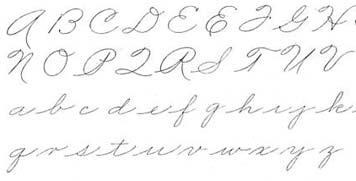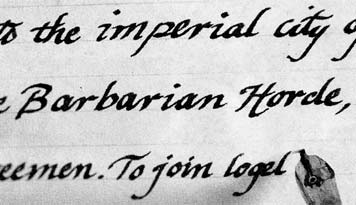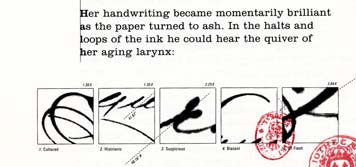
Every time I look at my son's handwriting, I find myself prognosticating about his future. Will Malcolm be good with his hands? Will his math skills lead him into science? Will his argumentative personality make him a championship debater? Will he follow his parents into design? Will he be happy?
Reading handwriting is an old art: graphology is one of the more articulated forms of divination, and handwriting analysis has long had the trappings of a science with its history and court experts. The assumption, of course, is that every hand is different, every stroke the sign of an individual's quirks and personality. It hasn't always been so.
In America, the idea of a prescribed form of handwriting was championed by Austin Palmer over a century ago. While working for the Iowa Railroad Land Company in the 1880s, he observed that clerks doing ornamental penmenship "flourished all capitals with a free-arm swing, with the arm completely off the desk." They used an entirely different movement to write normally. "The most swift and tireless penmen appeared to keep the arm on the desk at all times and formed their letters with little or no motion of the fingers — a free and tireless style of penmanship." Palmer realized that his "muscular movement writing" was something that could be taught and that advertising his "system" could help him to change the world — that everyone's handwriting could be efficiently executed while basically looking the same. There need not be confusion in the world because of a messy scrawl! The Palmer Method of Business Writing sold one million copies in 1912. By 1927, the year that Palmer died, 27 million Americans had learned the Palmer Method.

Source: Mike Sull's Spencerian Script and Ornamental Penmanship
The Palmer Method prevailed in the twentieth century throughout the American school system, not only as a way to teach penmanship, but as a method to ensure that all students would write the same. It took two generations to kill the legacy of Austin Palmer; as a result, my son's handwriting resembles nothing but his own gestural impulses. Ultimately, isn't this why we have hundreds of typefaces? Mercifully, Palmer died and went to heaven so that the richness of life and history and (hand)writing can survive.
These ruminations were inspired tonight by David M. Northrup, a retired English teacher in Rochester New York, who this week won the World Handwriting Contest. As reported by The New York Times, Northrup used to have normal handwriting — in the 1960s it was basically illegible. But he bought a fountain pen and began teaching himself a handwriting script based on a Renaissance italic. He graded homework and signed mortgage documents with his distinctive script. His students began saving their homework because of his craftsmanship.

Photo: Michael J. Okoniewski for The New York Times
Northrup turned to a Renaissance italic for a way to write, to take a fountain pen in his hand and to craft his own voice: he graded each student paper, one at a time, with this found voice. How is this different than Stephen Farrell creating Volgare, his font inspired by an early manuscript in the Newberry Library in Chicago? "Volgare is based on the 1601 handwriting of a clerk in Florence, Italy. This clerk was performing a simple act that is one hallmark of a civilized society: every time someone died, they added the name of that person, and the day that person died, and the neighborhood that person lived in, to a list." His novel with Steve Tomasula, VAS: An Opera in Flatland, takes this voice into even richer territory.

Source: VAS: An Opera in Flatland
I'm not really concerned whether my son, Malcolm, turns to the Renaissance for his inspiration. I'll leave that to him. I just hope he finds his own voice, his own way of writing with language. This will make him a designer in my eyes, forever.
[Should you wish to enter the World Handwriting Contest next year, please visit their website. Music composed by Thomas Campion.]
